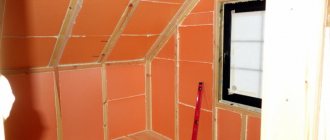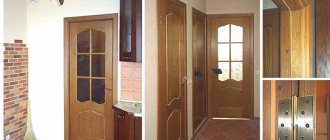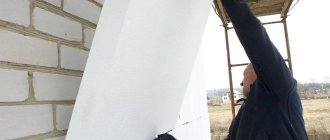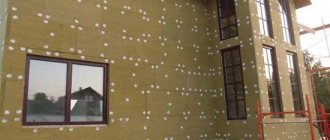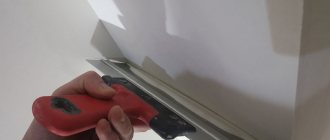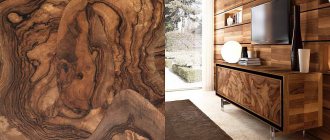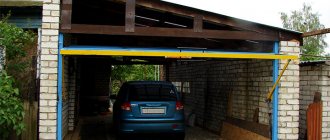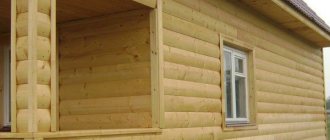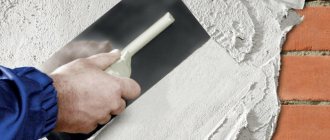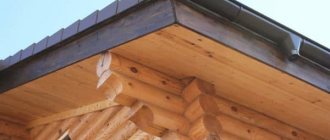Preparing walls (removing old wallpaper, priming)
The first thing to do is prepare the walls. This is the most important requirement, the compliance with which determines the quality and durability of the finish. Wall preparation occurs in several stages:
- Removing old coating. To make removing old wallpaper easier, you can use a metal spatula and soap solution. The walls need to be thoroughly moistened, then all material must be completely removed. Small pieces of wallpaper can be removed by applying a cloth to it and ironing it with a hot iron.
- Primer must be applied to clean walls. This is a mandatory step that affects the reliability of the wallpaper’s adhesion to the surface. Moreover, the primer strengthens the concrete itself, preventing its destruction and the appearance of fungus and mold. For these purposes, you can use primer glue, but there are also more successful compositions, such as acrylic primer.
- Puttying. This procedure is necessary only if there are cracks and other defects on the surface of the walls. Before applying the putty, the dried primer layer must be sanded with fine-grained sandpaper. Before wallpapering, only one layer of putty is needed.
The preparatory stage does not involve any difficulties, so anyone can cope with it. Proper preparation of the walls will ensure the durability and aesthetics of the final coating.
Preparing the wall surface for wallpapering with your own hands (with photo)
The final stage of finishing work is, of course, wallpaper work. The technology of wallpapering walls has certain subtleties.
It is not at all necessary to paste over the walls after plastering. Wallpaper can also be pasted on wooden and concrete surfaces. It is important to ensure that the base is strong and level. However, embossed wallpaper can be pasted even if there are slight unevenness on the walls.
Before gluing wallpaper with your own hands, you must remove all unevenness and dirt from the surface of the walls using a spatula or by sanding. If the walls are covered with lime or adhesive paint, they need to be wetted with water, thoroughly cleaned with a spatula to remove old paint and leveled. If there is emulsion paint left on the walls, there is no need to pre-prime, since such a coating itself serves as a good primer.
To prepare the walls for wallpapering, you first need to remove the old material by moistening it with water and leaving it for 10 minutes. This will allow you to easily remove the old coating.
To ensure reliable adhesion of the wallpaper, you need to apply glue along the perimeter, in the corners and at the top of the walls. When using flour glue, layering is done with drying oil, emulsion or liquid oil paint, and a strip 10-15 cm wide is drawn using a hand brush.
Wallpaper glue should be applied to the surface using a roller or terry brush. This is done in separate sections when the paste dries a little before wallpapering.
Selection and preparation of glue
Properly selected and high-quality glue affects the result of wall finishing. Thanks to a good adhesive composition, the wallpaper will stick without air bubbles, the joints will be invisible, and the canvas will be clean.
You need to choose wallpaper glue depending on the type of base of the canvas. So, for paper wallpaper, universal adhesive ACM (Italy) is suitable (https://finewall.ru/oboinii-kley/kley-acm-texreco-10-kg/), . Textile, as well as paper, but rather dense and heavy wallpapers are glued with French Semin Sem-Murale glue (https://finewall.ru/oboinii-kley/kley-semin-sem-murale-10kg/). For non-woven fabrics, a special non-woven glue Kleo Extra is provided (https://finewall.ru/oboinii-kley/kley-kleo-extra-35m2-flizelinovyy/). For fiberglass and manufactured and environmentally friendly wallpaper materials, a specialized adhesive is required, for example, glue for glass wallpaper Nortex (https://finewall.ru/oboinii-kley/kley-dlya-steklooboev-nortex-sukhoy-300-g/). There is also a universal option suitable for almost all types of trellises - Kleo vinyl glue (https://finewall.ru/oboinii-kley/dlya-vinilovih/)
In order not to make a mistake in choosing an adhesive, you need to consider several important points:
- The adhesive composition is selected depending on the type of both.
- When choosing an adhesive, take into account the room in which it will be used. So, for the kitchen or bathroom you need a special moisture-resistant glue with bactericidal properties, while for other rooms the usual composition is suitable.
- When choosing an adhesive, you need to pay attention to the pH value - it should be at least 7.
- Be sure to read the composition of the product. If it contains carboxymethylcellulose, the glue will be reliable and durable.
- For heavy types of wallpaper, you should choose an adhesive containing at least 50% polyvinyl acetate in its composition.
You should also keep in mind a few tips for mixing and using wallpaper paste:
- In the process of diluting the composition, it is necessary to pour glue into water, but not vice versa. This is necessary to ensure that the glue is uniform and without lumps. Stir the mixture continuously until the dry powder is completely dissolved. If lumps do form, they should be removed by straining the glue.
- The consistency of the glue should depend on the wallpaper chosen: the lighter it is, the more liquid the composition can be, and vice versa.
- Water for glue should be taken cold.
- After the composition is mixed, it should be allowed to stand for half an hour.
- During the application of glue, it is important to ensure that its distribution is even and thorough.
The quality and durability of the coating itself will depend on how correctly the glue is selected and mixed.
Glue preparation
All this is not so simple, because each type of glue is designed for different types of wallpaper. Some wall coverings are heavier, others less so. For example, most types of glue are suitable for paper wallpaper. Another thing is the non-woven base - the structure is already different. And vinyl wallpaper is too heavy for universal adhesives.
The glue is diluted with water according to the recipe indicated on the pack. To avoid the formation of lumps, it is recommended to pour the glue into the water slowly and stir constantly. Usually the mixture needs to sit for a few minutes to half an hour (see manufacturer's recommendation). After this, it should be mixed again.
Choosing wallpaper depending on the room
Today, stores and construction markets offer a huge number of different types of wallpaper, so you can choose the most suitable covering for each room. So, for smooth concrete walls, wallpaper with a smooth pattern or without it at all is perfect. If there are any flaws on the surface, it is better to give preference to embossed (voluminous) wallpaper.
The color of the walls should be chosen depending on whether the room is located on the south or north side. In the first case, cool shades are suitable: blue, light green, metallic. Such wallpaper will not only add freshness to the room, but will also visually increase its area.
To decorate walls in rooms on the north side, it is better to use warm shades of wallpaper: beige, yellow, brown. The corridor and hallway can be covered with washable wallpaper in rich colors. The bedroom should be done in calm undertones. Both dark and light shades look good in the living room. The main thing is not to forget about the general interior style and color combination.
Wallpaper gluing technology
Not all owners can correctly re-paste the wallpaper in their own apartment. If in the case of single-layer paper wallpaper there are no particular difficulties during the gluing process, then gluing walls with heavy wallpaper is not the easiest task.
The following algorithm of actions is suitable for gluing almost all types of modern wallpaper:
- calculation of the required amount of wallpaper and glue;
- purchase of necessary materials, devices and tools;
- selection and preparation of the place where the work will be performed;
- determining the location of application of the first canvas;
- building a scheme according to which gluing will be carried out;
- cutting wallpaper into sheets of the required sizes;
- glue preparation;
- gluing wallpaper to the surface.
This algorithm is suitable for gluing any type of wallpaper. The exception is photo wallpaper, where it is necessary to stick a large canvas, as well as wallpaper that requires selection of a pattern.
Pasting with pattern adjustment
Very often, especially among non-professionals, the question arises about how to properly glue wallpaper with a large pattern. To get a complete picture, you have to combine parts of the image located on two separate canvases.
We recommend: Water constantly flows in the toilet - we repair the tank ourselves
The following recommendations will help you with your work.
- When purchasing wallpaper with a large-scale pattern, you need to take one roll more than the calculated quantity. Many manufacturers indicate the size of the report on the packaging of their products, which allows you to more accurately determine the required number of rolls.
- Before starting repair work, you need to roll out two rolls on the floor and try to combine the pattern so that there are as few scraps as possible.
- Just in case, the canvases are cut out a few centimeters longer than when gluing conventional wallpaper.
Panels with a matching pattern are usually glued end-to-end. This allows you to connect two parts of one image with maximum accuracy without disturbing the geometry of the picture.
Wallpaper materials and tools
In order for the work to be completed continuously and efficiently, it is necessary to take care in advance of the availability of the necessary materials, tools and devices.
List of required products:
- wallpaper;
- wallpaper glue;
- two plastic buckets or other containers (for water and glue);
- two spatulas - one metal, the other wooden;
- rubber roller for smoothing wallpaper;
- paint brush and roller for applying glue;
- sharp scissors or construction knife;
- Ruler and pencil;
- roulette;
- laser level;
- sponge or clean rag to remove excess glue;
- towel or hand wipes;
- screwdriver and electrical tape for working with sockets and switches;
- ladder.
This is the minimum set of materials and tools that may be required to decorate walls with wallpaper.
Preparing the premises
In the room where work will be carried out, access to work surfaces (walls) must be provided.
Large furniture, a sofa, paintings from the walls, shelves, curtains should be removed and moved to another room - that is, those things that will interfere with the work.
For safety reasons, turn off the power, if possible, remove the frames of sockets and switches, unscrew the plastic baseboards and door frames. Once the work is completed, it can be put back in place.
Wallpaper should be glued in a clean room without dust and dirt. A thorough cleaning should be carried out before work begins. To protect the floor from glue, lay down plastic film or cardboard.
Doors and windows must be tightly closed - do not ventilate a room that has just been wallpapered for at least a day. Wallpaper does not tolerate drafts and temperature fluctuations. The canvases can simply “fall off” from the walls without having time to dry. And the work will have to be done again
Buying wallpaper - where is the best place?
Before you go to the store for wallpaper, you need to calculate the required amount of material, decide on the color scheme and type of wallpaper.
To calculate the number of wallpaper tubes, you can use the following method:
- Measure the height of the walls, then divide the length of the roll (10 m) by this number. The resulting figure will correspond to the number of whole canvases in one roll.
- Measure the length of all walls, divide the resulting number by the width of the wallpaper and the number of sheets in the tube.
When making calculations, you need to subtract doors and windows, and always round the results obtained only up. It is advisable to purchase 1-2 tubes of wallpaper in reserve in case of damage during gluing or use.
It is also worth considering that if the report (picture height) is more than 0.6 cm, you need to include in the calculations one more roll of wallpaper for every 6 tubes.
You can go to a hardware store or market to buy wallpaper and the necessary tools. A convenient and profitable option would be to buy online.
For example, the online store FineWall, specializing in the sale of wallpaper and other repair products, offers customers the opportunity to purchase high-quality products at competitive prices with the possibility of home delivery to any city in Russia or the CIS.
The FineWall online store forms an assortment of products depending on new releases. Buyers can see in the catalog the latest lines of wallpaper from the world's leading manufacturers.
The site presents both classic wall covering options and the latest trends in the world of wallpaper fashion. Fans of original prints and exclusive solutions will be pleased with the variety of products offered. Ease of purchase and fair prices without surcharges will also please customers.
Buying glue – which one is better?
It’s better not to skimp on wallpaper glue. It should be selected depending on the type of wallpaper and the quantity calculated according to the instructions indicated on the package. It is worth choosing material from a trusted manufacturer and do not forget to check the expiration date.
Where to start gluing
Some craftsmen claim that it does not matter where you start wallpapering. However, this is not entirely true. Still, it is better to start gluing the trellises (especially paper ones) from the window, and in different directions, so that the seams are not noticeable.
Determining the gluing pattern
The wallpapering pattern depends on the type of material. Paper ones are glued from the window in different directions. In all other cases you can glue:
- from the window;
- from the corner (it is necessary to draw a vertical line using a plumb line to mark the place from which the gluing will take place);
- from the door (the reference point in this case is the vertical line of the box);
- from an arbitrary location, from a vertical line.
The main thing you need to pay attention to when constructing a wallpapering scheme is the designation of a vertical line. It must be carried out using a social level, since any inaccuracies in this case will affect the quality of the walls.
Step-by-step instructions - what needs to be done?
To glue the walls, it is not at all necessary to turn to professionals. This can be done without outside help, following the appropriate instructions:
- Draw a vertical line using a plumb line and a pencil.
- Measure the height of the walls and cut the first piece. You can cut off 5-10 cm more in reserve.
- Cut the remaining strips taking into account the pattern, matching it on the floor, but in no case on the wall. If the wallpaper does not have a pattern, you just need to cut it.
- Prepare glue according to instructions.
- Apply the glue directly to the wallpaper. Walls should only be coated with non-woven wallpaper. First, one half of the canvas is lubricated and folded in half without fixing the seam. Then the second half is lubricated in the same way.
- When folded, the wallpaper should be left for about 5-10 minutes, depending on its density.
- Now you need to open the top half of the canvas and stick it on the wall, oriented vertically and not along the ceiling. The wallpaper should be smoothed well with a rubber roller from the center to the edges, from top to bottom.
- When one half is attached, you can straighten and stick the second.
- Excess wallpaper must be removed with a construction knife or scissors. The protruding layer must be wiped with a foam sponge or a clean rag.
- Using the same principle, glue the remaining canvases.
The instructions provided are suitable for most types of wallpaper and greatly simplify the task for beginners who have no experience in decorating walls.
Gluing and adjusting wallpaper
It is very difficult to find a room with absolutely vertical walls. Therefore, if you glue strips of wallpaper in accordance with the line of the walls, their inclined position will be difficult to avoid. To prevent this from happening, you need to align the first strip of wallpaper along a vertical line. Every few strips you should check that they are positioned correctly, especially when going around corners, so that you can correct the bevel of the wallpaper before the glue dries.
There are several ways to mark a vertical line on a wall.
Marking using a plumb line and a ruler. Having tied a weight to a rope and secured it with a nail or a button to the wall, you need to wait until the weight stops. After this, mark several points along the rope on the wall and use a ruler to connect them into a line.
Marking using a plumb line and chalk. You need to rub the plumb rope with colored chalk and secure the end of the rope to the top of the wall with a button or nail. When the plumb line stops and the rope hangs vertically without changing the position of the plumb line, pull it down slightly so that the rope is taut and press it against the wall, then pull it towards you and release the rope - the rope will leave a colored chalk line on the wall.
Marking with a metal ruler. If the metal ruler has a hole at one end, you need to insert a nail into it and nail it to the wall. After waiting for the ruler to take a vertical position, press it against the wall and draw a line along it with a pencil.
Using a plumb line, you need to draw a vertical line on the wall at a distance from the corner approximately 25 mm less than the width of the panel. To reach the ceiling, you will need a stepladder, chair or table. It is better to clear the approaches to the wall in advance, because the glue dries quickly and it is advisable to work quickly too. The prepared panel must be taken to the wall and the top edge coated with glue should be folded back. Then move the panel slightly upward so that it extends approximately 50 mm along the ceiling to the ceiling, and align the edge with the vertical mark on the wall. In this case, part of the canvas will wrap up and lie on the adjacent wall, covering the corner. Then you need to smooth the wallpaper with a soft cloth or brush in the direction from the center to the edges. Then unfold the lower part coated with glue and smooth it too, carefully aligning the wallpaper folded in the corner. The canvas should extend slightly onto the ceiling and baseboard (Fig. 3).
Having smeared the next cloth, you need to take it to the wall. Fold the top back, press it against the wall and align the pattern with the pattern on the first panel. Then smooth and trim the panel as indicated above. In this way, stick one sheet at a time. Typically, it is convenient for right-handed people to work clockwise, and for left-handed people to work counterclockwise.
Rice. 3. Gluing the first strip along the line.
- Bookmark allowance.
- Line alignment.
- Folded bottom end.
The general technology for wallpapering walls will look like this.
Rice. 4. Trimming the wallpaper at the top edge.
- Allowance on the ceiling.
- Sharp knife.
- Putty knife.
- Stage 1. Carefully coat the canvas with glue, paying special attention to the edges, and let it soak.
- Stage 2. Fold the part of the wallpaper coated with glue, applying glue to glue. This will prevent it from drying out.
- Step 3: Cross cuts can be made using a guide and a utility knife.
- Step 4. Press the plumb line against the wall and mark a vertical line. Pass it along the entire length.
- Stage 5. Carefully unfold the canvas, carefully aligning it along the marked line, and glue it.
- Rice. 8. Trimming the top edge of the strip according to the ceiling level: 1 - allowance on the ceiling; 2 - sharp knife; 3 - spatula
- Step 6. Using a brush or roller, smooth the canvas and remove air from under it.
- Stage 7. Using the back of scissors or a pencil, mark the cutting lines for the wallpaper near the ceiling and baseboard.
- Stage 8. Separate the wallpaper from the wall and cut along the intended line. Place the wallpaper in place and smooth it out. Trim the wallpaper near the baseboard in the same way (Fig. 8).
Removing air bubbles
No matter how carefully you work, air bubbles will still form from time to time. If the bubble is large, located in the middle of the panel and cannot be smoothed out, a simple syringe will help you cope with this problem. You must first puncture the bubble to allow air to escape. Then take a little glue into the syringe and use a needle to pour it under the wallpaper. Now all that remains is to smooth the surface of the canvas.
Pasting corners of rooms
Pasting of internal corners. Wallpapering corners is much more difficult than a flat wall. However, by adhering to a few simple rules, you can get a good result. It should be remembered that two walls forming a corner are rarely strictly vertical.
To adjust the location of the wallpaper, you need to draw a new vertical line right away. The slope of the walls is also the reason that when a strip of wallpaper goes around a corner, folds form on it. Therefore, professional upholsterers prefer to first cut the strip lengthwise into two parts, and then glue each separately: the first - slightly around the corner, and the second - overlapping the first. By cutting the strip in half, you can avoid another problem that will arise if you have to cover the inner corner with a whole piece of wallpaper: if the glue applied to the wall dries quickly, then the part of the strip located in the corner will eventually come off the wall, and any pressure on the it will lead to rupture.
When pasting external corners, these problems do not arise, since during the drying process the wallpaper will cover the wall better. Please note that if the overlap joint is located less than 5 mm from the outer corner, the edge of the wallpaper will likely fray from constant contact with people or furniture. Below is the order of pasting the inner corners from left to right. If you glue wallpaper from right to left, simply change the direction in the described sequence to the opposite.
- Stage 1. Measure the distance from the edge of the last glued strip to the corner at the ceiling and at the baseboard and add 10 mm. Cut the new strip lengthwise, using the larger of the measured distances as the width of the left piece. Glue this piece to the left of the corner and cut it off at the ceiling and baseboard.
- Stage 2. Having glued and cut the left piece of the strip, measure the width of the right piece minus 10 mm. Mark this distance on the wall and draw a vertical line through the marked point.
- Stage 3. Glue the right piece of the strip, guided by the previously drawn line, overlapping the left piece in the corner. Almost always the overlap line will be positioned crookedly, since the angle is not strictly vertical and the slope is large. The slight discrepancy in the pattern caused by this misalignment is hardly noticeable. If vinyl flooring is being glued, the joint must be trimmed twice.
Pasting external corners
Now let’s take a closer look at the technology for gluing external corners.
- Stage 1. Measure the distance from the edge of the glued strip to the corner and add 25 mm. Take these measurements at the ceiling and baseboard. Then cut a new strip lengthwise, taking the larger of the measured distances as the width of the left piece.
- Stage 2. Having pasted the left piece of wallpaper, smooth it to the corner, then cut it: at the top - exactly along the line of the ceiling, and at the bottom - along the edge of the baseboard. After this, the wallpaper will lie on the wall around the corner strictly along the plane. Smooth out the folded piece. Trim the wallpaper from the top and bottom.
- Stage 3. Having pasted and cut the left piece of wallpaper, measure the width of the right one minus 10 mm. Mark this distance on the wall and draw a vertical line through this point.
- Stage 4. Glue the right piece. The procedure for performing this operation is the same as for internal corners (see above). If you are gluing vinyl wallpaper, then you need to trim the joint twice.
If the room has a pipe enclosed in a casing or a protruding stand in the place where the partition was removed, it becomes necessary to cover both the internal and external corners with one strip. It’s better not to do this: even if one corner is vertical, the other, most likely, will not be so. You need to use the same techniques as when gluing wallpaper in the corners of the room. Beveling the edge of the bottom layer of wallpaper makes it less noticeable through the top layer. To do this, you need to cut a piece of wallpaper 25 mm wider than the next part of the wall leading to the first outer corner, and align the pattern in the outer corner. After this, bend 25 mm of the panel onto the adjacent wall and tear it along the edge. Apply the following strips in the same way.
Wallpapering around windows and doors
To some extent, the presence of casement windows in the room influences the choice of wallpaper pattern. Some discrepancy in the pattern near such windows cannot be avoided, so the best way to make it invisible is to use wallpaper with a fine pattern.
When applying wallpaper around doors and windows that have a frame made of baguette, you should fold the wallpaper and release it around the corners of the frame before you begin to smooth it onto the wall. Windows with casements that are not decorated with relief are much easier to paste over; it is enough to cover all four edges of the frame with wallpaper and stick them on the inner sides, overlapping them. With vinyl wallpaper, which cannot be glued overlapping, such an operation is much more difficult to carry out. Each overlap seam must be trimmed twice. To prevent the edges of the wallpaper from rubbing, the joints should not be placed at the edge of the window opening.
Pasting wallpaper in hard-to-reach places
General recommendations. In addition to doors and windows, in each room there are other difficult places to wallpaper - switches, sockets, mantels, end posts of staircase railings, as well as arches of niches and passages between rooms. It is inconvenient to paste wallpaper in such places, but there is an appropriate solution for each case. The main problem is that the glue dries in the time it takes to trim and adjust the wallpaper. Solving this problem is quite simple - you just need to have some glue and a small brush on hand.
Before you start gluing the walls, you need to remove as many “obstacles” as possible from them. Shelves, display cases, etc. are usually secured with screws driven into plugs inserted into holes in the walls. If the room has wall lights, turn off the power at the distribution panel or fuse box, remove the lights from the wall, and disconnect the power wires. Before turning on the power, you need to insulate the exposed ends of the wires with insulating tape. Always turn off the power when working near switches, outlets, or lights.
If you need to paste wallpaper on the wall behind the radiator, you just need to push about 150 mm of wallpaper past the top edge of the radiator, and then fold it in from the sides as deeply as possible. The ideal tool for rolling wallpaper onto a wall is a narrow paint roller for painting the walls behind the radiator. If there is a visible gap between the radiator and the baseboard, you need to stick wallpaper there too.
Wallpapering arches
In this case, additional difficulties are associated with combining the pattern. It is impossible to accurately match patterns on flat and curved surfaces. The best solution is either to use wallpaper without a pattern or with a random pattern, or to cover a curved surface with plain wallpaper that is in harmony with the wallpaper on the walls.
First you need to cover the walls on both sides of the opening. Then cut the panel so that 25 mm of wallpaper can be folded inside the arch. Make small V-shaped cuts on the folded part and press the tabs to the surface. Then cut out two panels of wallpaper 3 mm wide less than the thickness of the arch. Glue them inside the arch from bottom to top so that they overlap on the roof of the arch. The pattern on two vertical sections can be combined. At the top point of the arch, make a cut through the overlap and remove the trim.
Taping the wall around the faceplate
To apply wallpaper in this place, you need to turn off the power and loosen the screws securing the front cover of the switch or socket to the body. Then paste the wallpaper over the trim and press it against the trim to mark the corners. Using scissors, cut through the wallpaper in the center of the overlay. Next, you need to make cuts in the direction of each of the corners of the lining, forming four triangular flaps. Trim the valves to approximately 6mm. In such cases it is easier to work with small scissors. After this, the valves are tucked under the front cover and the wallpaper is smoothed with a brush, pressing it against the wall. Then tighten the screws, pressing the valves with a pad. After pasting the wallpaper, all switches and sockets can be turned on again.
Wallpapering around non-removable objects
To apply wallpaper around permanent objects, such as a mantel or banister end post, you must first apply a strip of wallpaper over the object and cut it roughly to the desired shape. In difficult corners, such as the top corner of a mantelpiece, or corners formed by small radius curves, use small scissors to make a series of small cuts along the edge of the wallpaper to allow the wallpaper to straighten along the wall. Then the resulting tabs are trimmed to 6 mm and all the panels are glued around the object. Now you can cut off all the 6mm panels using a sharp vinyl wallpaper knife and small paper wallpaper scissors. As you work, do not forget to wipe off any remaining glue. We must remember that it is much more difficult to remove dried glue.
How to make joints invisible?
The main mistake that beginners make is noticeable joints. As a result, the entire appearance of the finish suffers significantly. Typically, seams become noticeable for one of the following reasons:
- The glue is too liquid, which causes the wallpaper to sag at the joints.
- Low-quality wallpaper that stretches when exposed to moisture, then dries and shrinks, leaving a gap between the sheets.
- Incorrect gluing technology - overlapping.
If a similar problem is discovered before the wallpaper dries, it can be solved by rolling the seam with a narrow roller. But if the coating has already dried, there is only one way to solve the problem - paint the gap with paint that matches the tone.
Wallpaper glued with an overlap must be cut in the middle of the seam with a construction knife a few hours after the work. Not completely dried glue allows you to remove unnecessary pieces of wallpaper.
How to properly glue wallpaper in corners?
In the outer corners you need to start gluing the wallpaper, bringing the first strip 1-2 cm beyond the corner. The first canvas is glued overlapping directly from the corner. If the double stripe is visible, you need to press the seam tightly with a spatula, make a cut with a construction knife and remove the remaining excess material, and then smooth the seam.
When working with outer corners, the technique is almost the same: the first strip needs to be placed a few cm around the corner, and the second one should be glued overlapping. After this, you need to apply a ruler to the corner and make a vertical cut using a stationery knife, cutting off the edges of 2 canvases and smoothing the seam between them with a rubber roller.
Pasting technology
To know how to properly hang wallpaper, you should first study the technology of the process. Here you must follow the following sequence:
- First, you need to measure the surface that you plan to cover and calculate how many rolls of wallpaper you will need to buy.
- Rolled materials and glue are purchased.
- Determine where to start gluing wallpaper in the room, and use a plumb line or laser level to mark a vertical line for gluing the first sheet.
- Cut the trellis to size.
- Prepare the adhesive composition.
- Separate sheets are glued.
Determining the required number of wallpaper rolls.
Materials and tools
Before you hang the wallpaper yourself, you will need to purchase the necessary materials and tools.
The following materials :
- rolled materials that are suitable in their qualities for the room in which repairs are planned;
- glue suitable for the selected type of wallpaper.
The following tools :
- trestles or stepladder;
- container for diluting the adhesive composition;
- water container;
- cuvette;
- roller and brush;
- wide spatula;
- stationery knife;
- a special spatula for smoothing wallpaper;
- roulette;
- plumb line or laser level;
- pencil;
- scissors;
- rubber rollers of different sizes for smoothing trellises on the wall surface;
- napkins.
Where to start gluing
There is no absolutely correct order for pasting - it is selected based on the characteristics of the room and the type of wallpaper.
When carrying out end-to-end gluing, it does not matter where to start the movement, but, traditionally, experienced finishers begin gluing from the window . This option allows you to avoid the appearance of shadows at the joints of sheets if the overlap gluing method is used, but it is also perfect for the butt seam technique.
It is convenient to start pasting from the doorway, since the door frame is aligned strictly vertically. There is also a method of gluing trellises from the corner if it is formed by smooth, vertical walls (this option is possible when preparing the surface from gypsum plasterboard, plywood or OSB).
When working with photo wallpaper, the canvas is marked so that the overall picture is in the center of the surface. In accordance with this requirement, the place of the first sheet and the order of pasting are determined.
Scheme for pasting the room
When you start placing trellises from the window, the first sheet is glued from the edge of the window and moved to the right or left. At the same time, they begin moving on the other side of the window and lead in both directions until the intersection of the trellises in the center of the opposite wall.
It is preferable to join the lines in corners or near doorways, which will disguise the uneven joint of the pattern.
When gluing from a corner, you will need to measure a vertical line for the first sheet using a plumb line, then the trellises are glued in order to the opposite wall. The same is done when the movement starts from the doorway.
Step-by-step instructions for pasting
Wallpapering walls is not a task that requires high qualifications - most owners are able to cope with this work on their own, but in order to avoid common mistakes, it is enough to follow the following step-by-step instructions, which will be relevant both for the old “Khrushchev” and for a modern new building:
- Having decided on the place to start work, you need to use a plumb line or laser level to draw a vertical line, which will serve as a guide for gluing the first sheet.
- Using a tape measure, the height from floor to ceiling is measured and the material is cut according to this size. To adjust the trellises according to the pattern, it is usually enough to make an allowance of 100 mm.
- It is better to combine a complex pattern on a free area of the floor, and only after that cut the fabric.
- The adhesive solution is prepared in a separate container.
- To apply glue to walls and trellises, use a roller and a brush (a brush will be needed for high-quality coating of corners). In cases where non-woven wallpaper is used, the glue is applied with a roller only to the wall.
- It is recommended to fold wallpaper soaked in glue in half on both sides with the adhesive side inward.
- The upper part of the trellis is opened and placed in its place on the wall, the material is smoothed with a wallpaper roller or a special plastic spatula, after which the lower half of the trellis is opened and pasted in the same way.
- Excess wallpaper from above is cut off using a wide metal spatula, which serves as a base and limiter, and a stationery knife. The wallpaper can be cut from below with scissors if the baseboards have been removed, or, just like from above, if the baseboards remain.
- Smoothing the trellis is done with a plastic spatula or a regular napkin; it is advisable to roll the joints between individual sheets with a rubber roller.
- According to this scheme, pasting is performed sequentially sheet by sheet.
This scheme is universal, but for some types of roll materials there are peculiarities in the pasting technology, and therefore before starting work you should carefully study the instructions included with the wallpaper and wallpaper glue.
How to glue on windows and doors
The most difficult place to glue wallpaper is in places where there are various obstacles, such as windows and doors. To hang wallpaper in door areas without any problems, you need to follow a certain algorithm:
- Paste wallpaper over the doorway.
- Join this canvas with the previous one and press the wallpaper tightly to the wall.
- Make a cut diagonally to the top corner of the doorway.
- Roll the wallpaper onto the top and side trim of the door using a rubber roller.
- Trim protruding parts of the material with scissors or a stationery knife.
- Place the remaining strip under the trim with a spatula. If the platband fits tightly to the wall, the wallpaper needs to be trimmed evenly.
It is not difficult to glue wallpaper near a window. Here you need to use the most common technology: when the material is completely dry, cut off the excess wallpaper along the edge.
How to hang photo wallpaper?
Seamless photo wallpapers are made of paper or non-woven fabric, the top layer is usually made of textile. They have a width of 2.5 to 3 m, and the length can reach 50 m. Such wallpaper cannot be cut - it is glued to the wall as a whole. In this case, it is necessary to follow a special gluing technology:
- First you need to prepare the wall: remove the old coating, plaster and putty if necessary.
- Prepare the adhesive composition
- Start gluing the fabric. You should start from the section of the wall that will be covered with curtains or furniture.
- During the gluing process, you need to secure the photo wallpaper at the top and bottom using special fixing strips, and level the canvas with a rubber roller or spatula.
- Every 1.5-2 meters pasted, it is necessary to check the verticality with a level
- Cut holes for sockets and switches, as well as make door and window openings.
- Excess material can only be trimmed after the wallpaper is completely dry.
It is better to glue together a fabric that is too large. One person should gradually unwind the roll, holding it at a slight angle, and the other should coat and glue the wallpaper.
Preparatory stage
First, everything in the room that can be removed is removed, including door frames and baseboards, if possible. They also remove sockets and switches, closing the boxes with wires with plugs - plastic or wooden.
You also need to know how to glue wallpaper correctly
Turn off electrical outlets
When working with electricity, we de-energize the room and do not turn it on until we are finished. It is advisable to carry out all work, including wallpapering, with the power turned off. The work is “wet”, and water or glue can get on the wires and short out. If the wiring is done according to all the rules and there are protective circuit breakers, this is not a big deal. They'll just turn off the power and that's it.
If the wiring is still done in the old way, it can be dangerous. The worst part is that in this case there is often no way to turn off the power in a separate room. Only in the entire apartment or, at best, in half of it. Then the solution is to remove the power wires from the sockets and switches (with the power off, of course) and carefully insulate the ends, then hiding them under plugs. Then you will have to unwind them and put them back in place, but it will be safe.
Lighting during work is temporary - extension cords are pulled from other rooms and portable lamps are turned on. Once you have dealt with electricity, you can move on.
If the walls are just leveled and puttied, you don’t need to do anything other than primer. But if they have an old coating - wallpaper or paint - they will have to work. First, remove the previous finish.
Cleaning off old wallpaper
If wallpaper is pasted on the walls, pry it up in a random place with the corner of a spatula, then pull it by the bent corner, tearing it off. If you're lucky, entire strips come off, sometimes several meters long in a single strip. But more often it comes out in small fragments. First, they remove everything that comes out “dry”. If it’s really difficult and in small parts, take a bowl of water and a roller and wet the walls in this way. To make them come off easier, you can add dishwashing detergent to the water.
Things don't always go so well
If the wallpaper is paper, water is simply applied to the surface. If they are vinyl or with some other durable film, first they break through the film. This can be done using a spiked roller, or with a brush with metal bristles. The main thing is to break through the film so that water can be absorbed into the base - paper or non-woven fabric - and soak the glue. Sometimes you need to wet the wallpaper several times to make it come off easier.
Next, the steps are the same as with paper ones: pry them with a spatula and tear them off. Sometimes this technique of tearing off pieces is ineffective. It works faster if you scrape off the soaked finish with a spatula. Then scrape the blade along the wall at an acute angle. In general, it doesn’t matter how, but the old wallpaper must be completely removed.
Removing paint and whitewash
You also have to work with a spatula, scraping off centimeter by centimeter. The work is monotonous and rather tedious, and also dirty. There are several ways to speed things up.
Oil paint on concrete
There are actually two options: chemical and mechanical. Chemical - these are special paint removers. The composition most often looks like a gel. They are applied to the surface and, after some time, (indicated on the packaging) it rises with bubbles or begins to shrink. The paint has softened and can be removed with any spatula.
This is what the paint looks like after the “work” of washing
Everything happens quite simply, but there are two “buts”. First, the price of the wash is quite high. Secondly, the fumes are clearly not useful. You need to work in a ventilated area, but do not let the remover dry, otherwise there will be no effect. And still, even with ventilation, sometimes my head hurts. So a respirator won’t hurt, and gloves are a must.
The mechanical method is not just a spatula. This will take a very long time to scrape. Use a grinder or hammer drill. The grinder has brushes made of metal wire. You can try to remove it like this. The method works, but not always or it is too slow. Then you can take a hammer drill and a chisel, and holding the chisel perpendicular to the surface, move it along the wall without deepening it. The paint bounces off quickly. After such a “shock” treatment, all that remains is to clean off the residue with a spatula.
Water-based emulsion, whitewash or paint on gypsum plaster
Removing this type of paint on walls is no easier. You can scrape it off, just very, very slowly. The solution is very simple: again water and a special paint scraper. You can buy it at a hardware store. Immediately take several spare blades: for example, the kitchen needs three or four of them.
Coat the wall well with water. Brush or roller, several times possible. Then you leave it to soak. And then you start cleaning with a scraper. The paint just pops off. It is only important that the wall is well wet.
Read how to choose wallpaper for the corridor and hallway here.
Sealing irregularities
Here you will first have to assess the condition of the walls. First you need to remove all the nails and screws, remove chips and repair cracks. Then examine the results. If the walls are more or less even, there are only small defects, you can get by with occasional leveling. Only cracks, dents and chips are repaired. They can be covered with finishing putty. Just before leveling, completely clean the wall of dust and pieces of wallpaper, and then cover it with a primer (with a wall roller and a brush in the corners).
If the wall has been “treated” with a hammer drill, you cannot do without full putty of the entire wall. Mostly today they use gypsum putty. First, apply a layer of primary or starting. It has a coarser grain and the layer can be up to 3-5 mm. This composition is used to level out the main unevenness, trying to achieve a smooth surface. After drying, they pass through a special mesh, removing any unevenness or sagging that may exist.
Afterwards finishing putty is used. It is very plastic and is applied in a thin layer - up to 1-2 mm. After this, the wall becomes smooth (after the irregularities have been smoothed out with a mesh, only with a smaller mesh).
Primer of walls
The second layer of primer is applied after puttying. It forms a film on the surface that reduces the absorption of the glue and also improves adhesion. For wallpapering, you can use a thinner wallpaper glue as a primer. Each pack has a table indicating the amount of water for gluing and priming. We dilute the glue in the required proportion, wait for it to be ready (also on the package) and cover the walls with the composition. The priming technique is the same: first go over the corners with a brush, then with a roller on smooth surfaces.
In the video, for some reason, the use of primary putty is called plaster, but otherwise the sequence of actions is presented correctly.
The rules and methods for combining wallpaper are described in this article.
How to hang composite photo wallpaper?
If the wallpaper consists of 4, 8 or 12 parts, they must first be laid out on the floor, inspected for defects, and then followed according to the algorithm developed by professionals:
- Draw a vertical line - this is where the edge of the canvas will go. If the picture consists of 4 parts, it should start from the center, and if it consists of 12, it should start from the edge.
- Next, you need to measure the height and width of one part of the picture and make markings on the wall so that everything falls into place. You should also take into account door and window openings, switches, sockets and other obstacles.
- Then fold all the fragments so that the canvas that needs to be glued first is on top. Fold all sheets pattern down.
- Spread one fragment with glue and attach it to the desired area of the wall, smooth and level it.
In the process of gluing such wallpaper, it is important to monitor the accuracy of combining the fragments into one pattern. You should also avoid the appearance of air bubbles, stains and other defects.
Gluing process
The proposed instructions will help you cope with gluing any type of wallpaper yourself.
- First, prepare glue that matches the type of canvas. This is easy to do: dry adhesive powder is diluted in the proportions described on the packaging, stirred well and left to swell.
- Glue is applied to the cut piece with a brush. They begin to spread the sheet from the center, moving to the sides. The edges are processed especially carefully.
USEFUL INFORMATION: Anaerobic sealants for threaded connections
- After applying the glue, the strip is folded in half with the edges together. This way the coated side will be on the inside. It is important to prevent wrinkles from forming. The strip should be left for a short period of time indicated on the roll packaging. As a rule, for simple paper types it takes 5 minutes, and for thick ones - about 10. When moistened, the wallpaper can stretch a little, so they need to be soaked for the same amount of time. This way you can avoid the material from lagging behind the walls and the formation of bulges.
Important! When working with glass wallpaper and non-woven fabrics, the adhesive composition is applied to the wall, and not the material itself.
- The first strip is applied to the wall, aligned along the marking line, and the next sheet is glued end-to-end. There is no need to overlap when working with vinyl, non-woven, fabric types of wallpaper. It is only allowed when attaching thin paper products. If there is a pattern on the wallpaper, it needs to be combined correctly. Particular attention should be paid to the joining of the offset pattern.
- The strip that is glued is gently pressed with a dry cloth or rolled with a roller. You need to move from the middle towards the edges, as well as from bottom to top.
- If the plinth is removed, the lower edge of the canvas after gluing must be cut so that it is hidden behind it. If removal is impossible, trim the strip at the level of the baseboard. Instead of a ruler, it is convenient to use a wide metal spatula.
- The upper edge is removed along the edge of the ceiling molding, and the lower edge is leveled along the baseboard on the floor. It is also convenient to use a wide spatula and a very sharp knife for this. Trimming is carried out immediately after leveling the strip; in this case, it will be smooth and without burrs.
Important! If the wallpaper is glued after installing the stretch ceiling, trimming must be done very carefully so as not to damage the film.
- Now all the edges along which you need to go with a rubber roller are carefully checked. Areas that do not stick are coated with glue again and pressed tightly against the wall.
At what temperature should you glue wallpaper?
Previously, wallpaper manufacturers and professional craftsmen recommended gluing walls at an air temperature of 23-25°C. But since such temperature indicators can only be achieved in the summer, manufacturers have improved the wallpaper taking this feature into account.
Modern materials manufactured using the latest technologies can be glued at a temperature of 10-25°C. It is not recommended to allow temperatures that are too low or too high.
When can you open windows after pasting?
Many people make the grave mistake of opening windows immediately after wallpapering. This leads to uneven drying of the glue, and, as a result, to divergence of seams or peeling off of entire canvases.
Freshly hung wallpaper is not afraid of drafts only after it is completely dry. This usually takes 1-3 days. The exact drying time can be found in the instructions for using glue and wallpaper. In any case, it is better to play it safe and wait another day.
What to do if the wallpaper bubbles?
The formation of air bubbles under recently hung wallpaper is a fairly common problem. This happens due to non-compliance with gluing technology. Such a defect looks unaesthetic; moreover, air cavities are a potential place for the formation of mold and mildew. Therefore, it is important to eliminate the bubbles as early as possible.
If the bubbles are too large, it is useless to try to stick them without tearing the wallpaper off the wall. In this case, you will have to re-glue the entire canvas.
If the wallpaper has a rather motley pattern, you can cut the air pockets with a utility knife and eliminate the air. Using a thin brush, apply glue to dry areas and smooth the wallpaper. Under no circumstances should you do this procedure with plain wallpaper. Any manipulations with the knife will immediately be evident.
When cutting the wallpaper in places where there are air pockets, you need to remember that the paper material dries out, so you should make a slight overlap. This does not happen with non-woven wallpaper.
If the bubbles appear because glue has accumulated under the wallpaper, you can pierce them or slightly cut them, then smooth them out with a rag, squeezing out the excess glue. But you should understand that, again, this is only possible in the case of wallpaper that has a pattern.
If the bubbles are small, they can be removed using a regular syringe. The needle must be quite thick so that it can pass the glue. You need to pierce the bubble at an acute angle from the edges to the center. If there are large wrinkles left, it is better to smooth them out, and small ones will disappear on their own after drying.
What to do if the wallpaper is see-through?
The biggest trouble a decorator can encounter is translucent wallpaper. Unfortunately, it is not possible to correct this problem, so you need to take all necessary measures at the preparatory stage:
- Dark walls need to be lightened. To do this, you can use a special primer or water-based paint.
- Buy wallpaper made of dense material.
- Make sure that the wallpaper is not see-through by placing a small piece of material against the wall and assessing its density.
How long does it take for wallpaper to dry?
The time for complete drying of pasted walls depends on several factors: the type of glue, the density of the wallpaper, air humidity and room temperature. The drying interval is within 12-72 hours.
Paper-based non-woven wallpaper and duplex paper wallpaper take the longest to dry (about 3 days). Vinyl and non-woven wallpaper (not paper-based) dry in just 1-2 days.
You can find out whether the wallpaper is dry or not by pressing your palm against the wall. If you feel cool at the same time, the wallpaper has not yet dried, but if the wall is warm, then the walls are already completely dry.
It is also worth noting that under no circumstances should you artificially dry wallpaper using heating devices. This will inevitably lead to their deformation.
How to glue meter-long wallpaper alone?
Not long ago, meter-long wallpaper appeared (to be precise, the tube is usually 90 cm wide). This type of finishing material has several advantages:
- a small number of joints are obtained, as a result of which the finish looks more neat and of high quality;
- significantly saves time and effort on repairs;
- Buying such wallpaper is often more profitable than standard tubes.
- the surface for gluing must be perfectly flat and prepared;
- It may be difficult to calculate the required amount of material;
- It is quite difficult to glue such wallpaper alone.
However, meter-long wallpaper also has its downsides:
It is not easy to hang such wallpaper alone; most likely, you will need the help of a second person. But if it is not possible to involve someone else in the repair, you can do it yourself. In this case, you must follow the instructions provided for gluing ordinary wallpaper. Difficulties may arise directly at the stage of gluing the panels to the wall - here you will have to show a certain physical strength and dexterity. Otherwise, the process of decorating walls with meter-long wallpaper is no different from gluing classic wallpaper.
Nuances of work production
In the process of gluing surfaces, it is necessary to take into account a number of restrictions and rules that will allow finishing work to be completed with high quality.
When is it better to glue wallpaper - in summer or winter? In fact, it is not the time of year that plays a role, but the temperature in the room. At what temperature is it best to apply pasting? Experienced craftsmen claim that the optimal temperature is from +10 to +25°C, and therefore there is no need to do finishing work on the verandas and attics of a country house in the cold autumn or winter - the room must be heated.
When can you open windows in a wallpapered room? In this case, you need to understand how long it takes for the wallpaper to dry. Typically, the complete drying process takes from 24 to 72 hours, and therefore windows cannot be opened quickly.
If the wallpaper is not allowed to dry at the recommended temperature, uneven drying of the adhesive may occur, which leads to individual sheets peeling off and, as a result, the need to redo everything.
There are also special features of performing work when gluing corners, joining individual sheets and placing trellises near windows and doorways.
At windows and doors
Not every home craftsman manages to cope without problems with pasting walls in places of contact with windows and door blocks. To facilitate work with doorways, the following procedure should be followed:
- the trellis is glued on top of the door block;
- the adjacent sheet is fastened in the same way, joining it to the first one;
- Next, you need to firmly iron the trellises at the points of contact with the wall;
- using scissors, remove excess trellis, freeing up the opening;
- if the platbands have not been dismantled, the wallpaper is glued to it by rolling a rubber roller over the surface of the material;
- excess material is removed with scissors, and small edges are carefully tucked under the casing with a spatula;
- if the contact density of the platband and the wall is maximum, trim the excess wallpaper flush using a wide spatula and a utility knife.
Wallpapering near window openings is done using the same technology, but trimming the excess fabric is done after it has completely dried.
In the corners
Pasting corners causes the greatest difficulties for beginners. To properly secure the rolled material in the corner, you should consider the advice of experienced finishers:
- It is not recommended to use a full sheet to cover a corner - it is best to cut it in width so that the overlap on the adjacent wall does not exceed 10-30 mm;
- the connecting trellis on the adjacent wall is glued to the corner sheet with an overlap, adjusting the pattern, after which it is necessary to make an accurate cut in the middle of the overlap of the two panels, remove
- excess stripes and carefully smooth the joint with a rubber roller.
The technology for gluing external corners is no different from the method of gluing wallpaper in internal corners.
Pasting the outer corner.
Pasting the inner corner.
Hiding joints
If the technology for gluing wallpaper is violated, unsightly joints of adjacent sheets often result - the trellises diverge, leaving a piece of the wall open.
Marriage at work manifests itself for several reasons:
- when preparing the adhesive solution, the technology was violated, as a result of which the glue turned out to be less concentrated than required by the instructions;
- wallpaper that is too soft can expand greatly when saturated with glue, and after drying it shrinks, leaving the joints open;
- if the gluing technology was violated and the trellises were joined poorly.
To avoid this problem, it is necessary to carefully treat the joints of the wallpaper with a rubber roller when gluing. This way the trellises will be securely fastened at the points of contact.
If the joints have come apart and you don’t want to redo the repair, you can use a simple camouflage idea - tint the surface of the wall between the trellises with water-based paints that match the tone.
Some tips from the professionals
In order to properly hang wallpaper, you should listen to the advice of those who have been doing wall finishing work for a long time.
- Before you start gluing wallpaper, the room should be well ventilated. It is advisable to do this one day before the proposed work.
- The skirting boards in the room must be removed in advance and reattached after finishing. This will make wallpapering much faster and easier.
- It is advisable to cover the floors in the room with newspaper or cardboard so as not to stain them with glue.
- Instead of a table, chairs and other furniture, it is better to use a stepladder. Various furniture can scratch the floor or walls; moreover, it interferes with the wallpaper at the bottom of the wall.
- You should pay attention to the quality of not only the wallpaper, but also the glue. It must match the type of wallpaper chosen and have the appropriate consistency.
- There is no need to join the wallpaper in the corners. It is better to glue them with a slight overlap, then cut them vertically with a knife along the seam and remove excess materials.
- Keep your hands and tools clean. If this requirement is neglected, there may be traces of dirt on the wallpaper.
- If possible, do not cut the fabric at the top and bottom. It is advisable to hide inaccuracies using plinths or baguettes.
- When cutting wallpaper, the stationery knife must be held horizontally so as not to tear the paper.
- To prevent the glue from hardening on the knife, before cutting the wallpaper, you need to pour boiling water over it.
- It is not necessary to remove the battery at all. You can cut the wallpaper in the area where the pipes are attached, stick it on and smooth out any unevenness.
By gluing the wallpaper yourself according to the instructions given and taking into account all the recommendations of professionals, the result will certainly please both the master himself and the rest of the household.
